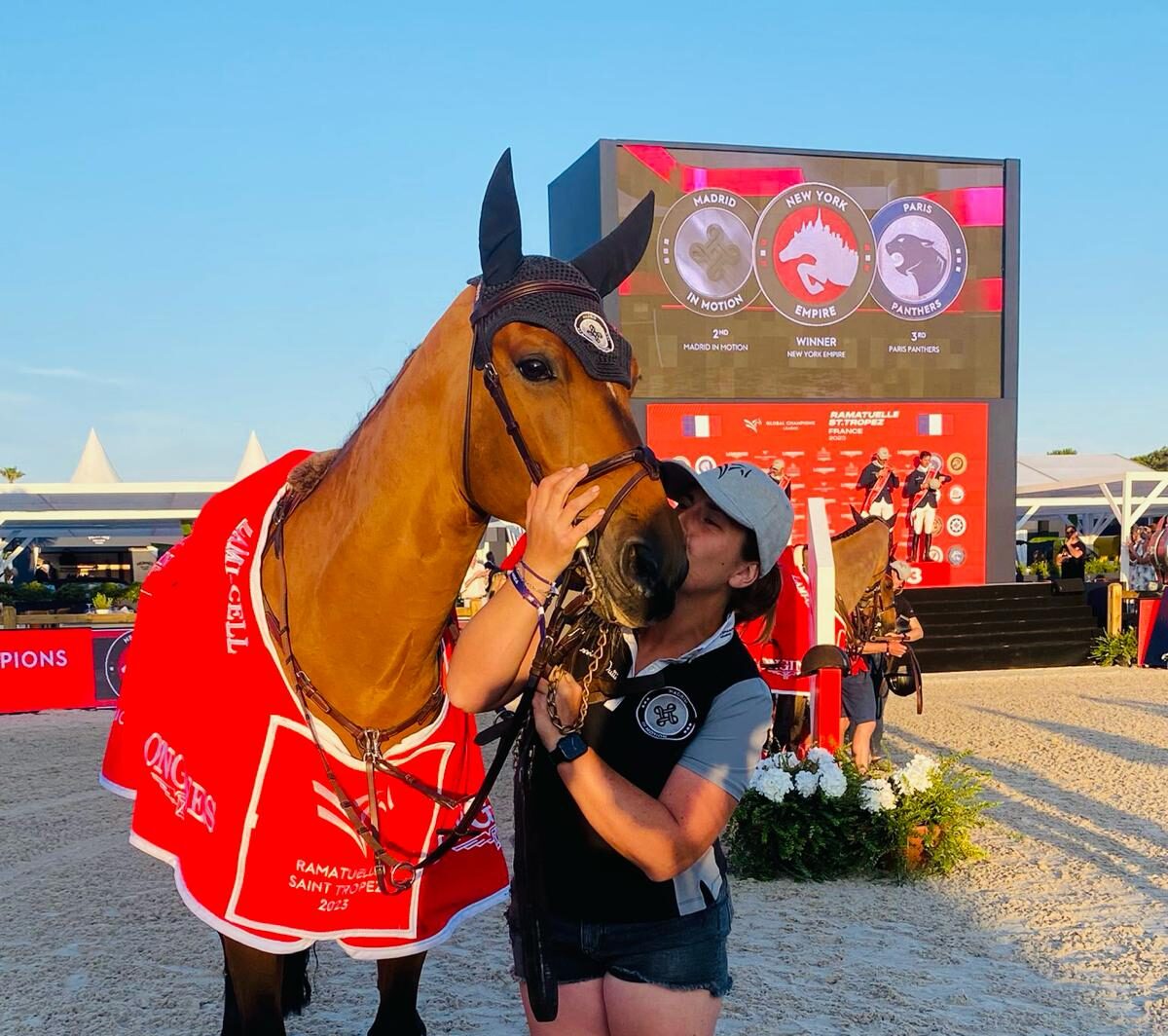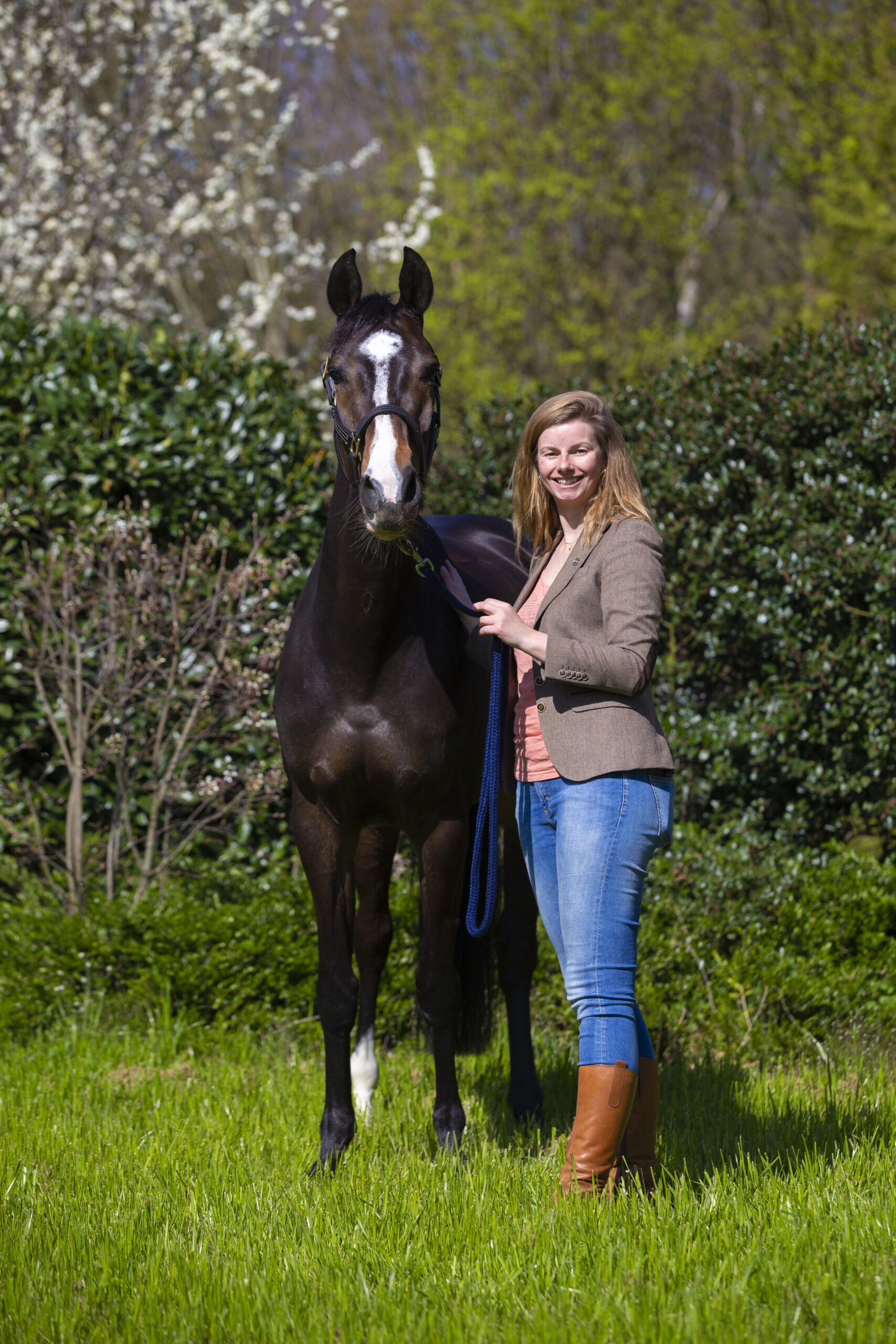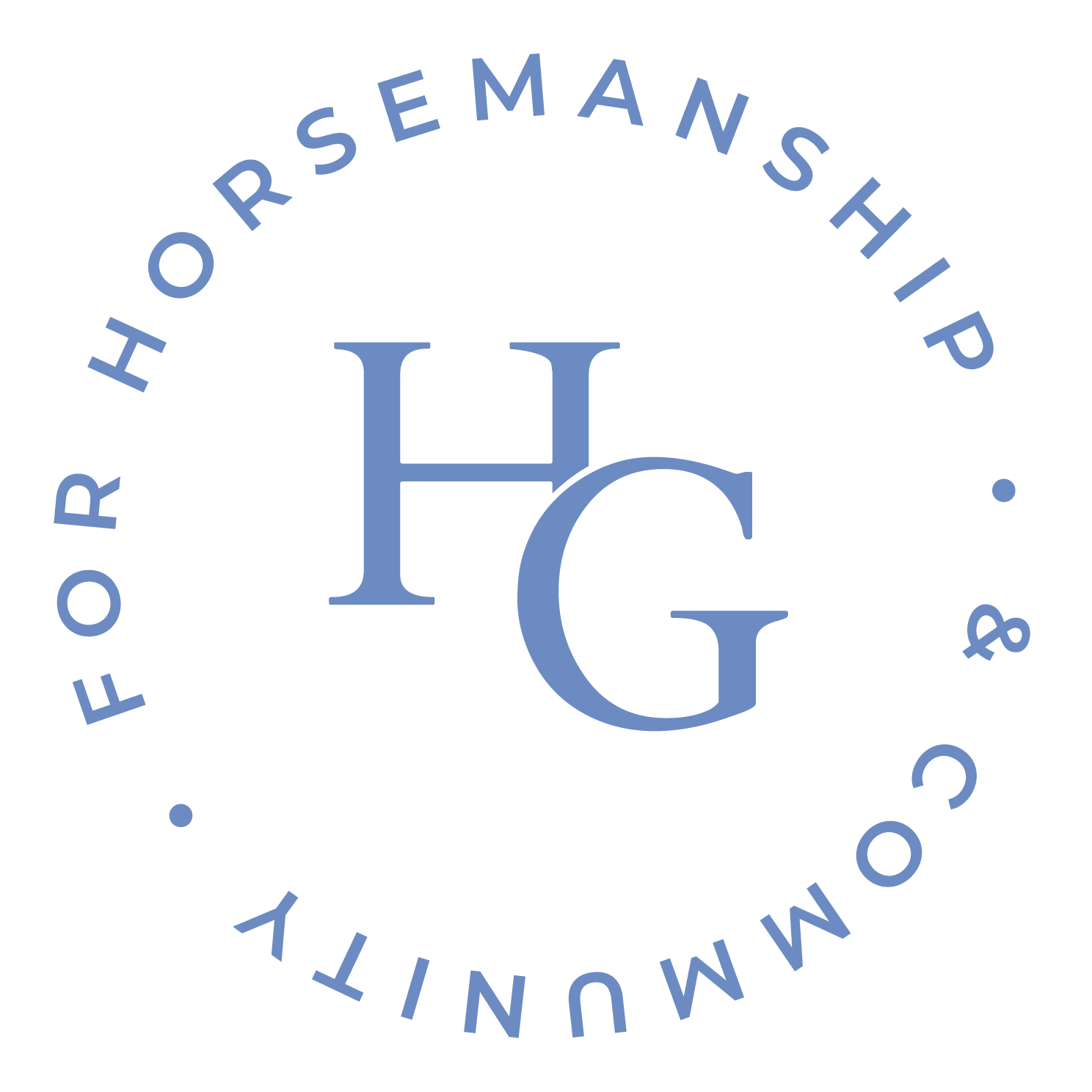For about a year, Alin Seidler has worked as international Dutch show jumper Maikel van der Vleuten’s show groom. The Someren, the Netherlands-based rider earned team silver and individual bronze in the 2022 Herning World Championships, individual bronze in the Tokyo Olympics, team and individual gold in the 2021 Barcelona FEI Nations Cup Final and team gold in the 2014 Caen World Equestrian Games. Before van der Vleuten, Seidler worked with Italian show jumper Alberto Zorzi, German show jumper Nicola Pohl and the Holsteiner Verband. She started her career as a groom with Japan’s Takashi Haase Shibayama. HorseGrooms caught up with Seidler during CSI5*-W Amsterdam.
What have you learned from the riders you worked with?
What I have learned in general is that you should see every horse as an individual with different needs and they all have a different character. It doesn’t matter if you work with stallions, geldings or mares. You really have to develop the feeling for that and to learn about the differences between horses. You also need to learn to trust your gut feeling. If you think a horse shows unusual behavior, then you have to trust your gut. You know the horses as a groom; you know their body language, and if something is different, you wonder why. That is the point of trying to support the horse, to stop, for example, a light colic.
I went from the Holsteiner Verband to Nicola Pohl. She was the first rider with whom I could discover a bit how five-star events work. We didn’t go a lot to these shows but enough to find out how it worked. It also gave me the opportunity to learn from the other grooms. This was kind of the start of everything. My learning got better at Stal Tops [where Zorzi was based at the time]. Everything went more into detail, more intensive. It was getting more into a system, and they had a good system.
You said that at Stal Tops, everything is in a system. What specifically did you learn there?
Basically everything: how to drive long distances and how to really handle the horses. I already learnt a few things during my time with Nicola Pohl and before, but during my time at Tops, I learnt on the Longines Global Champions Tour how to manage the tours. [It was on a different level than I had experienced before.] You go from one Global Tour to another, and you sometimes have only one day to change horses. You also have to manage the stopovers, make them work and keep the horses fit at that level. That means you have to make sure they are doing well. I also learned how to do the training plan with Alberto and all that. That’s all part of it. You only learn that by doing it. Also I experienced going to small shows with the young horses, bringing them forward again and seeing them grow up and maybe become something later.
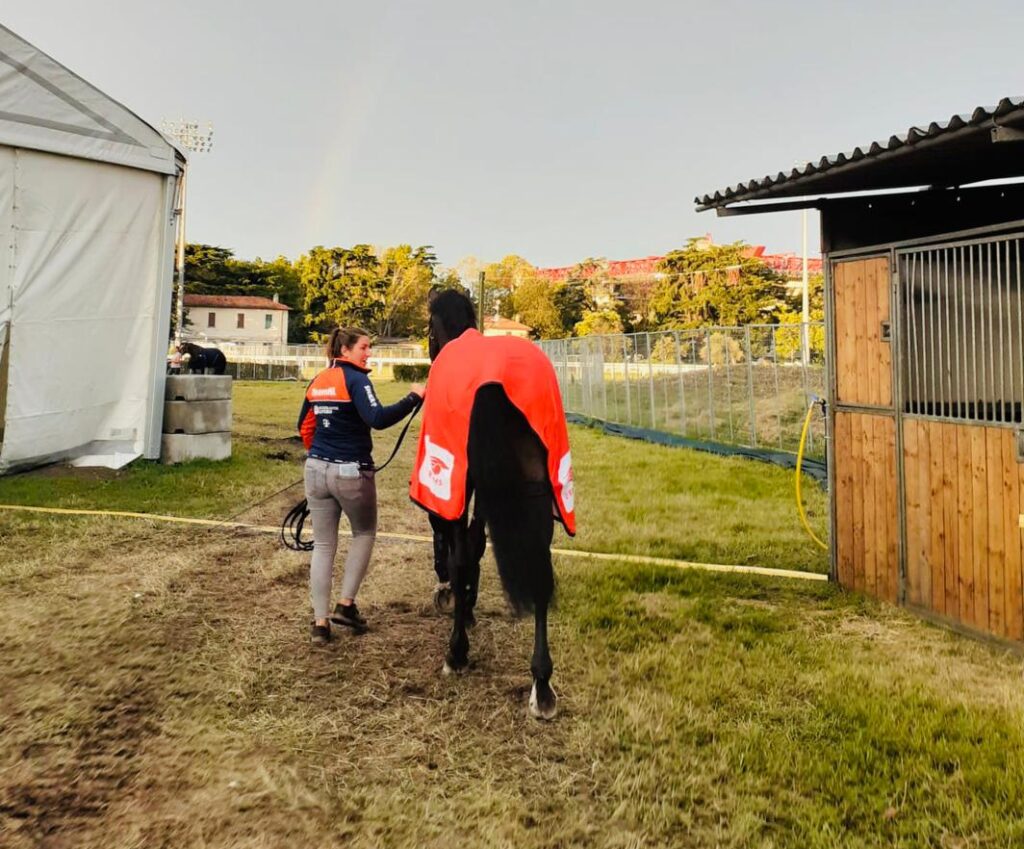
Are you only a show groom or also a home groom?
At the moment I am very busy being a show groom. Of course, I also help at home when I am home for a day or two, but I am mostly at shows.
Can you describe a day in your life as a show groom?
I start by feeding hay; I muck out the stalls; then I feed them hard feed. We feed them Red Mills and lucerne (alfalfa). We don’t give them many extras. The younger horses get Pavo SportsFit muesli. We keep it relatively simple. Then I start hand walking or Maikel starts riding. It depends on what the day brings. Or I walk the horses first or longe a few, and then he comes to ride the horses for the competition. After the show, I make their bed and clean the tack. Our feeding routine is the same as at home. We start with feeding hay then later hard feed and change the water; at 11 a.m. we hay again and at 12 give hard feed. Late in the afternoon they get hay again and hard feed. I add mash to the hard feed they get in the late afternoon for the supplements that I give (like electrolytes). In the evening I do night check and give my horses a bit of hay.
I use the BEMER Horse Set at every show and two times a day, in the morning and in the evening. It also depends on what kind of show we are at. I only use it at the show because the horses deliver a top performance at shows. There the BEMER can really support the horses. At home the horses don’t need to give the same kind of performance. That is why I don’t find it necessary to use the BEMER at home.
We really like to learn from the way the grooms work. What can you tell us about your leg and hoof care at shows?
First of all, I would like to point out that everyone has a different system, and we believe in different things that work for us. For me, it is also very individual. All horses are different. It also depends on what kind of history a horse has. A healthy horse with no history or injury, like a tendon injury, is different from a horse with a history of injury. On the first day the horses usually jump the warm-up class. After that I only put Tendonil on their legs. Almost every horse in my care has only stable bandages on their front legs. I use Uptite Poultice after the last class of the weekend. It depends on the horse and what they have jumped. If they have jumped a bigger class or a grand prix, I put Uptite and Arnica on. I actually use baking paper which I wet and wrap around the area with Uptite and then bandage the legs. The baking paper is ideal because it is already cut into pieces and fits perfectly.
I use hoof grease every day on the inside and outside of the hooves. Before a class, I put hoof oil on the hooves, and, in the evening when I get them ready for the night, I put hoof grease on them.
What about tail care?
To be honest, we don’t brush the tails at home with Maikel. I only do it at shows. The tails are washed and ShowSheen is applied, and then it works really well. That was their system when I came. I am taking it over.
Do you have any tips for new grooms?
It is always important to me that new grooms really want to learn and come to us and ask how to do things. We have also learned to ask questions of older grooms and see how they do things. That is how you learn. You will never stop learning. I am still learning a lot. I would say that new grooms need to be open to everything, open to different influences and also open to the horses–also not to give up when things get difficult. It is important to keep trying and get out of your comfort zone. Sometimes you will have a difficult horse, and you have to find a way to work with it, to have patience and everything that goes with it.
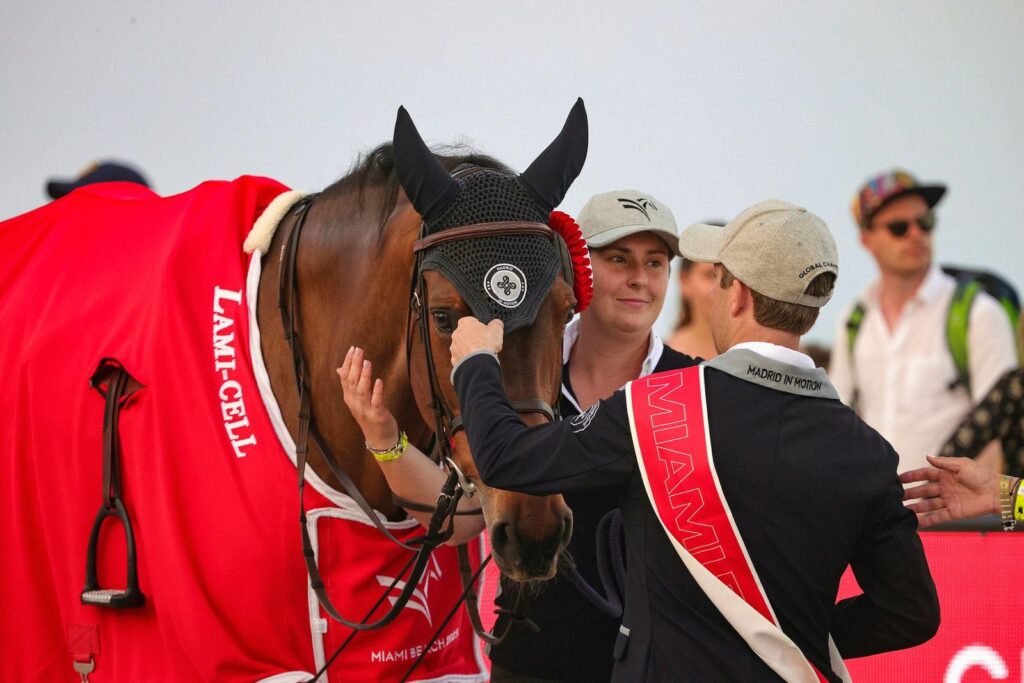
I have noticed that it is different nowadays. What is different is that I think the perspective has changed from the new generation. This is from my own experience. I find that the new grooms want to go to the big shows, but sometimes they forget that we all started at the small shows going to national shows with five horses, a full day and a full weekend, and worked really hard. During my time at the Holsteiner Verband, I was always on tour with the stallions. That’s a bit missing now; they don’t want to go to the small shows. They want to go to the big shows and a lot of them think it is really easy to go to the big shows, for example, to go to a Global with two horses–but we are still working all day. It doesn’t mean we have just two classes. The horses needed to be flat-worked from 6 to 7:30, and at 8 the two-star classes start. Before that, the horses are getting lunch, we hand-walk the horses again. In the afternoon, we hand-walk again. After that we have the classes, and we are late finishing. We are not there to go on a holiday, though we still enjoy being in different countries and seeing more from the world. There are also new grooms who take the job seriously and love it because of the horses.
It also takes time and experience to find the right rider to work with. If it doesn’t work out, you should look for a new job. I have been very lucky with the riders I have worked for.
What are some of the routines you use when grooming the horses?
In winter, I have a bucket of water mixed with a little baby oil. I picked this up from watching older grooms. I use this in my grooming routine for the coat. It allows the coat to breathe from all the clipping and blankets. The coat doesn’t look as good in the winter. I use baby oil in the winter, and vinegar in the summer.
Do the horses (including stallions) go out to paddocks or fields?
Yes, we have special stallion paddocks with higher fencing. They can graze there. All horses go outside. At Maikel, it is normal for the horses to enjoy their time outside. We usually have a group outside in the morning and in the afternoon. As long as they are comfortable being outside, they can stay outside. I think it is a good thing. During this wet period, the horses are given more time on the longe so they can play and roll. The horses have a varied program. Maikel and his family are a horse family through and through.
What is it like for you to work with stallions? Have you been working with stallions for many years?
I love stallions. I like to have horses in my care that have a special character, that are difficult and so on. I like them because they have a personality. When you have them on your side, they are 100% with you. That is what I love about my job. That you can teach them to work with you, that they trust you 100%, whether it is in a container being transported on an airplane or hand walking at a show.
Let us take an example from your current work. With O’Bailey VH Brouwershof N.O.P., now a 10-year-old stallion, you are growing into the higher levels of his career. How is this journey for you?
I really like him. He has an outstanding character; he is very sensitive, but at the same time very vocal. He is very present. He is one of the sweetest stallions I have ever had in my care. He doesn’t bite, and he doesn’t kick. He was quite shy when I first had him because he didn’t know me.
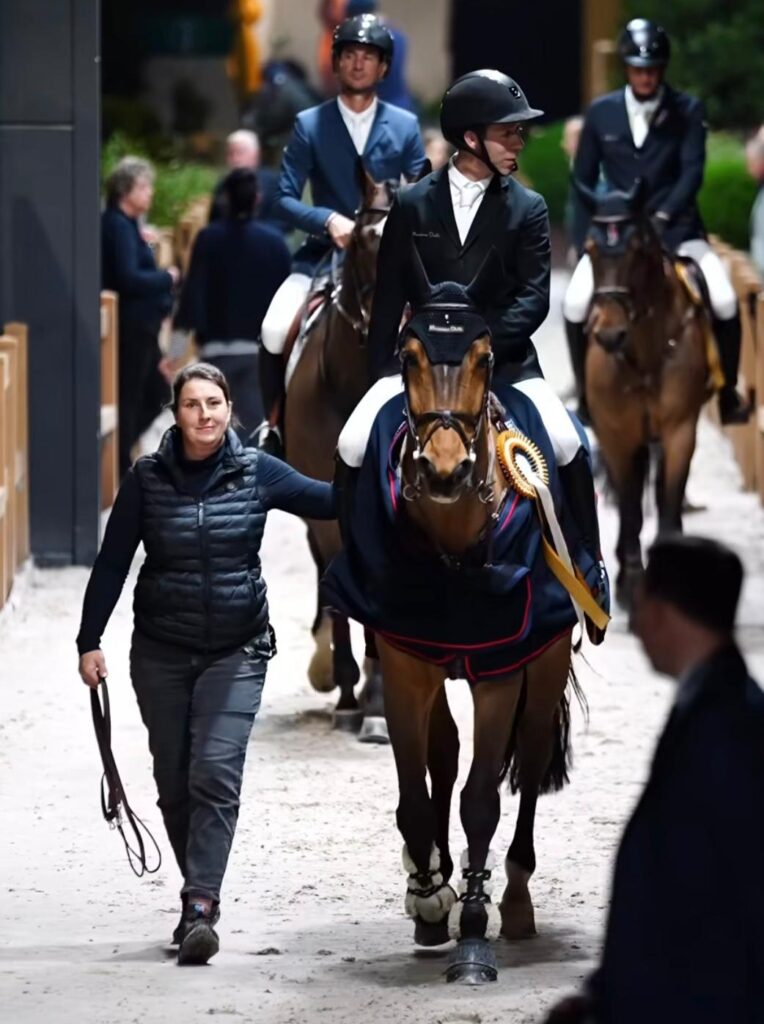
I have that with the mares too. It is the same thing, but I really like it when the horses have a bit of personality. Beauville Z N.O.P. is a very sweet gelding; everyone loves him. His stable name is Bobby, and it is Bobby’s world, and we all live in it. Most people say I spoil my horses, but they are not; I just want them to be happy.
How did you get into horses?
I lived in a big city, and my father was a truck driver and was only at home on the weekends. As compensation, or as father-daughter time, he took me to a riding school. That’s how it built up more and more. This was the case over the years. I also had my own horse. We moved from the city to the countryside, and it was easier there. After school, my bag ended up in the corner, and I went to the horses. Then I went to a riding club and helped with tacking up, cleaning the stables and taking care of the horses. Horses were really a part of my life, and I turned my hobby into my profession.
How did you become a groom?
I started as a groom a long time ago with Takashi Haase Shibayama. That was really at the beginning. I had no driving license, nothing. After him I went to the Holsteiner Verband. At a show in La Coruña I saw a stallion that I had in my care at the time, Stanfour. He was very nice. I wasn’t really sure if it was him, but the Holsteiner Verband was still connected to him, so I was sure it was Stanfour.
Why did you decide to become a show groom?
I started working for the Holsteiner Verband. We mostly went to national shows but sometimes to two-star shows. We went to Neustadt-Dosse in Germany, for example. That was at a different level. If you want to be a show groom, you have the opportunity to see more of the world. It takes a while to reach that level, but maybe you have the goal of going to the Olympics. There are grooms who groom until the Olympics and then stop. I don’t think I’m one of them because I like the job too much to stop. I want to do it as long as I am healthy. It is my dream job otherwise I would not be able to do it for so long.
